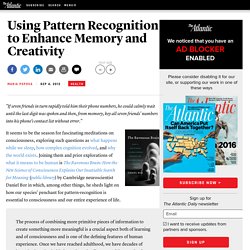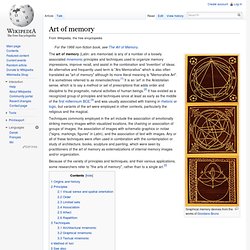

Yes, You Too Can Read at 1000 Words Per Minute - Testing Circus. Ever wondered how to read faster.

Here is a solution that will allow you to read 1000 words per minute. How to Learn Without Memorizing. Photo by Edwin Stemp Rote memorization is an inefficient way to learn.

Just retaining a single formula can mean pounding the same information into your skull dozens of times. If your computer hard drive had this accuracy, you’d probably throw it out. Unfortunately, you’re stuck with your brain. The good news is that you don’t need to learn by memorization. Home Page. This wiki is a collaborative environment for exploring ways to become a better thinker.

Topics that can be explored here include MemoryTechniques, MentalMath, CriticalThinking, BrainStorming, ShorthandSystems, NotebookSystems, and SmartDrugs. Other relevant topics are also welcome. SiteNews Wiki Topics Mindhacker: The support page for the 2011 book by RonHaleEvans and MartyHaleEvans. How To Learn Without Memorizing. How To Memorize Things Quickly.
People like to joke that the only thing you really “learn” in school is how to memorize.

As it turns out, that’s not even the case for most of us. If you go around the room and ask a handful of people how to memorize things quickly, most of them will probably tell you repetition. That is so far from the truth, it’s running for office. If you want to memorize something quickly and thoroughly, repetition won’t cut it; however, recalling something will. The problem is that recalling something requires learning, and we all learn in different ways. Using Pattern Recognition to Enhance Memory and Creativity - Maria Popova. "If seven friends in turn rapidly told him their phone numbers, he could calmly wait until the last digit was spoken and then, from memory, key all seven friends' numbers into his phone's contact list without error.

" It seems to be the season for fascinating meditations on consciousness, exploring such questions as what happens while we sleep, how complex cognition evolved, and why the world exists. Joining them and prior explorations of what it means to be human is The Ravenous Brain: How the New Science of Consciousness Explains Our Insatiable Search for Meaning (public library) by Cambridge neuroscientist Daniel Bor in which, among other things, he sheds light on how our species' penchant for pattern-recognition is essential to consciousness and our entire experience of life.
Memorizing Dates - How To Remember Dates For A Test. Dates are often difficult to remember because they seem so random and obscure unless we can relate them to something specific.

For instance, the American Civil War started in 1861, but unless you have a strong interest in the specific timeline of the war, there is nothing special about the starting date that separates that date from any other. What makes 1861 stand apart from 1863 or 1851? Pinyin / Ting - The Chinese Experience. Improve Your Memory with The Chunking Technique. Pi Memorisation. This section will help you memorize Pi.

Pi is defined, in Euclidean geometry, as a constant which is the ratio of a circle's circumference to its diameter. Why Pi? Pi is a challenge to memorize because the number of digits in it are infinite, and there's no discernable pattern anywhere to the order of the digits. Art of memory. The art of memory (Latin: ars memoriae) is any of a number of a loosely associated mnemonic principles and techniques used to organize memory impressions, improve recall, and assist in the combination and 'invention' of ideas.

An alternative and frequently used term is "Ars Memorativa" which is also often translated as "art of memory" although its more literal meaning is "Memorative Art". It is sometimes referred to as mnemotechnics.[1] It is an 'art' in the Aristotelian sense, which is to say a method or set of prescriptions that adds order and discipline to the pragmatic, natural activities of human beings.[2] It has existed as a recognized group of principles and techniques since at least as early as the middle of the first millennium BCE,[3] and was usually associated with training in rhetoric or logic, but variants of the art were employed in other contexts, particularly the religious and the magical. I need to go to my mind palace. Have you deleted anything from your.mind palace yet?

I've just began creating/using mine so i began with small things that are unimportant. i think i can't delete them yet because i don't have.a lot of info yet. any suggestions? Deleting things can be somewhat difficult! It’s a lot easier to create an idea than it is to destroy one, especially if it’s one so interesting that it’s hard to forget about. I have a room filled with things that are either semi-permanent or temporary, the to-do list room. Some are reoccurring items, ( reminders to study and such ) but a lot are things that get checked off once and then deleted. The way I delete those items is by imagining a little trash bin popping up, like the recycling bin on your computer, then putting the trigger ( no matter how big it is, it will fit somehow ) into the trash can, then pushing the trash can out of my view and back into the void whence it came.
I do have problems with “ghost triggers”, as I like to call them. Pimp Your Memory: How to Build a Mind Palace like Sherlock Holmes. You’ve all seen that scene in the Baskerville episode of BBC’s Sherlock (if you haven’t, you’re missing out, mate) where the show is about to reach its climax and Sherlock, in that flat, bitchy tone we’ve all come to love, commands: “Get out.

I need to go to my Mind Palace.” John Watson explains it’s a memory technique which, in theory, means you’ll never forget a thing, and then we see Sherlock (with the aid of a visual manifestation of his mind, including a particularly funny moment when Elvis Presley’s face is superimposed on his) link together all the clues they’ve been given to solve the mystery of HOUND. Develop Perfect Memory With the Memory Palace Technique. The Memory Palace is one of the most powerful memory techniques I know. It’s not only effective, but also fun to use — and not hard to learn at all. The Memory Palace has been used since ancient Rome, and is responsible for some quite incredible memory feats. Eight-time world memory champion Dominic O’Brien, for instance, was able to memorize 54 decks of cards in sequence (that’s 2808 cards), viewing each card only once.
And there are countless other similar achievements attributed to people using the Memory Palace technique or variations of it. Even in fiction, there are several references to the technique. How to Remember Stuff with a Memory Palace. The Method of Loci" The oldest known mnemonic strategy is called the method of loci ("loci" is the plural of locus, which means location, or place). It's based on the assumption that you can best remember places that you are familiar with, so if you can link something you need to remember with a place that you know very well, the location will serve as a clue that will help you to remember. Devised during the days of the Roman Empire, the method of loci is really a sort of linking method with a twist. According to Cicero, this method was developed by the poet Simonides of Ceos, who was the only survivor of a building collapse during a dinner he attended.
Simonides was able to identify the dead, who were crushed beyond recognition, by remembering where the guests had been sitting. From this experience, he realized that it would be possible to remember anything by associating it with a mental image of a location. LOCI Method of mnemonic memory technique. Your Memory Palace: Method of Loci. Memory Enhancing Technique The method of loci, also called the memory palace, is a mnemonic device introduced in ancient Roman rhetorical treatises.
It relies on memorized spatial (of or relating to facility in perceiving relation of objects) relationships to establish, order and recollect memorial content. The term is most often found in specialized works on psychology, neurobiology, and memory, though it was used in the same general way at least as early as the first half of the nineteenth century in works on rhetoric, logic, and philosophy.
Method of loci is also commonly called the mental walk. 30 Tips to Improve Your Memory. Method of loci. The Method of Loci (plural of Latin locus for place or location), also called the memory palace , is a mnemonic device introduced in ancient Roman and Greek rhetorical treatises (in the anonymous Rhetorica ad Herennium , Cicero 's De Oratore , and Quintilian 's Institutio oratoria ). The items to be remembered in this mnemonic system are mentally associated with specific physical locations. [ 1 ] It relies on memorized spatial relationships to establish, order and recollect memorial content.
The term is most often found in specialised works on psychology , neurobiology and memory , though it was used in the same general way at least as early as the first half of the nineteenth century in works on rhetoric , logic and philosophy . [ 2 ] Description [ edit ] O'Keefe and Nadel refer to 'the method of loci', an imaginal technique known to the ancient Greeks and Romans and described by Yates (1966) in her book The Art of Memory as well as by Luria (1969). Contemporary usage [ edit ]